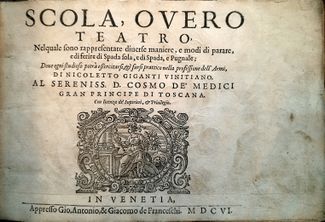|
|
You are not currently logged in. Are you accessing the unsecure (http) portal? Click here to switch to the secure portal. |
Difference between revisions of "Scola, overo teatro (Nicoletto Giganti)"
| Line 10: | Line 10: | ||
<!----------Information----------> | <!----------Information----------> | ||
| − | | full title = | + | | full title = ''Scola, overo teatro, nelquale sono rappresentate diverse maniere, e modi di parare, e di ferire di spada sola, e di spada, e pugnala'' |
| also known as = | | also known as = | ||
| author(s) = [[author::Nicoletto Giganti]] | | author(s) = [[author::Nicoletto Giganti]] | ||
| Line 24: | Line 24: | ||
| genre = [[type::Fencing manual]] | | genre = [[type::Fencing manual]] | ||
| sources = | | sources = | ||
| − | | publisher = [[publisher:: | + | | publisher = [[publisher::Giovanni Antonio & Giacomo de' Franceschi| ]]Giovanni Antonio & Giacomo de' Franceschi |
| pub_date = [[year::1606, 1610, 1619,<br/>1622, 1628, 1644|1606, 1610, 1619, 1622, 1628, 1644]] | | pub_date = [[year::1606, 1610, 1619,<br/>1622, 1628, 1644|1606, 1610, 1619, 1622, 1628, 1644]] | ||
| first English edition = | | first English edition = | ||
| Line 33: | Line 33: | ||
| below = | | below = | ||
}} | }} | ||
| − | ''''' | + | '''''Scola, overo Teatro''''' ("School, or Fencing Hall") is an [[nationality::Italian]] [[fencing manual]] written by [[Nicoletto Giganti]] and printed in 1606. It treats the use of the single [[rapier]] and the rapier and dagger. The treatise is structured as a series of progressively more complex lessons, and Tom Leoni opines that this treatise is the best pedagogical work on rapier fencing of the early 17th century.<ref>Leoni, p xi.</ref> It seems to have been quite popular based on the number of republications over the succeeding decades and the acclaim given it by fencing historians, who note among other things that Giganti is the first to fully describe the use of the lunge. |
== Publication History == | == Publication History == | ||
| − | '' | + | ''Scola, overo Teatro'' was first printed in Venice in 1606 by Giovanni Antonio and Giacomo de' Franceschi. The Grand duchy of Tuscany granted Giganti a special protection against unauthorized reprints for a term of 30 years, but this copyright was repeatedly ignored, including a 1610 printing and the 1628 edition published in Padua by Paolo Frambotto. |
| − | + | In 1619, still within the copyright period, the treatise was translated into French and German and published in Frankfurt by De Zeter under the title ''Escrime Novvelle ov Theatre''. He also included translations of [[Salvator Fabris]]' treatise, which has oddly been the source of various accusations of plagiarism against Giganti by fencing historians. This parallel edition was reprinted in 1622 and again in 1644. | |
| + | |||
| + | In 2010, ''Scola, overo Teatro'' was translated into English by Tom Leoni and published by [[Freelance Academy Press]] under the title ''Venetian Rapier: The School, or Salle''. | ||
== Contents == | == Contents == | ||
Revision as of 19:57, 31 October 2013
| Scola, overo Teatro | |
|---|---|
| School or Fencing Hall | |
 | |
| Full title | Scola, overo teatro, nelquale sono rappresentate diverse maniere, e modi di parare, e di ferire di spada sola, e di spada, e pugnala |
| Author(s) | Nicoletto Giganti |
| Illustrated by | Odoarco Fialetti |
| Dedicated to | Cosmo de Medici |
| Place of origin | Siena, Tuscany |
| Language | Italian |
| Genre(s) | Fencing manual |
| Publisher | Giovanni Antonio & Giacomo de' Franceschi |
| Publication date | 1606, 1610, 1619, 1622, 1628, 1644 |
| Pages | 95 pages |
| Treatise scans |
|
Scola, overo Teatro ("School, or Fencing Hall") is an Italian fencing manual written by Nicoletto Giganti and printed in 1606. It treats the use of the single rapier and the rapier and dagger. The treatise is structured as a series of progressively more complex lessons, and Tom Leoni opines that this treatise is the best pedagogical work on rapier fencing of the early 17th century.[1] It seems to have been quite popular based on the number of republications over the succeeding decades and the acclaim given it by fencing historians, who note among other things that Giganti is the first to fully describe the use of the lunge.
Publication History
Scola, overo Teatro was first printed in Venice in 1606 by Giovanni Antonio and Giacomo de' Franceschi. The Grand duchy of Tuscany granted Giganti a special protection against unauthorized reprints for a term of 30 years, but this copyright was repeatedly ignored, including a 1610 printing and the 1628 edition published in Padua by Paolo Frambotto.
In 1619, still within the copyright period, the treatise was translated into French and German and published in Frankfurt by De Zeter under the title Escrime Novvelle ov Theatre. He also included translations of Salvator Fabris' treatise, which has oddly been the source of various accusations of plagiarism against Giganti by fencing historians. This parallel edition was reprinted in 1622 and again in 1644.
In 2010, Scola, overo Teatro was translated into English by Tom Leoni and published by Freelance Academy Press under the title Venetian Rapier: The School, or Salle.
Contents
| Page | Section |
|---|---|
| A1 - A3 | Preface by Nicoletto Giganti |
| A4 - B3v | Publisher's preface |
| 1 - 47 | Rapier by Nicoletto Giganti |
| 48 - 95 | Rapier and dagger by Nicoletto Giganti |
Gallery
Additional Resources
- Leoni, Tom. Venetian Rapier: The School, or Salle. Nicoletto Giganti's 1606 Rapier Fencing Curriculum. Wheaton, IL: Freelance Academy Press, 2010. ISBN 978-0-9825911-2-3
References
- ↑ Leoni, p xi.















